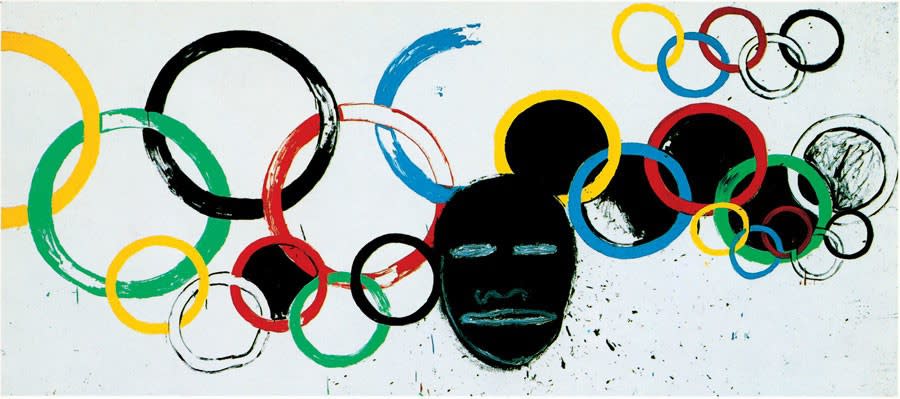
Warhol’s 1977 silkscreen ‘Athletes’ series featured ten multi-coloured portraits of the most celebrated athletes of the time. Between March and November 1977, Warhol travelled across the United States, to take Polaroid photographs of each sports star. At his studio, the Factory, he transferred his chosen frames to canvas and applied the colour using his silkscreening technique
From boxer Muhammed Ali to basketball player Kareem Abdul-Jabbar, tennis player Chris Evert and ice hockey player Rod Gilbert, the sporting series captured the distinct expressions of the different sporting legends: from Ali’s intensely focused gaze to football player Pelé’s soft smile. Commissioned by friend and collector Richard Weisman, the series sees the sporting icons depicted in punchy hues of clashing, colliding colours against bold backgrounds. The Athlete series is notable as the 70’s was a particularly busy period for Warhol where he would produce a great amount of portraits. Indeed, what is particularly of note is Warhol’s choice of subject matter
In 2008, the series was shown at the Faurschou gallery in Beijing to coincide with the 2008 Summer Olympics. Explore original Andy Warhol art for sale.
Meanwhile, Hockney’s pool paintings of swimming scenes in California have a more languid, leisurely mood. The swimming pool featured as a favoured setting for many of his works spanning the 1960s and 1970s. Hockney’s depiction of muscular mortals entering or exiting the water’s rippled surface captured the varying strokes and states of swimming. A Large Diver (Paper Pool 27) (1978) sees a figure underwater, his legs and arms sprawled in an outstretched motion. Dive into David Hockney prints for sale.
Meanwhile, Keith Haring depicted many writhing and dancing figures in his artworks. Inspired by breakdancing and hip hop synonymous with 1960s New York street culture, his use of rhythmical, energetic moving figures captured the expressive style of movement and dance, infusing his works with energy and animation. Haring’s use of vibrant colours and bold lines evoked the aesthetics of Pop Art, as seen in ‘Untitled (Dance)’ created in 1987, which depicts a line of multi-coloured figures in diverse, dynamic poses. Discover Keith Haring original art for sale.
Basquiat’s Untitled (Orange Sports Figure) was created in 1982, the year he became an internationally recognised rising star. Consisting of vibrant acrylic, oil stick and spray paint, the orange, yellow and red hues evoke a fire-hot temperature that perhaps signifies the heat of sport, the tense temperature of the game. The grid-like structure at the bottom of the canvas is inspired by the template of a baseball scorecard, whilst an actual baseball, parallel to the figure’s face, can be seen hovering mid-air, perhaps mid-flight. Beneath, the lines across an arrow pointing upwards echoes the stitching of the baseball, whilst also indicating the direction that the ball might be travelling. The layered artwork may nod to one of Basquiat’s heroes: the right fielder baseball player Hank Aaron. Basquiat’s inspirational icons, such as boxer Joe Louis, were identified by their proximity to his infamous crown motif which can be seen scrawled in the torso of the figure. Browse Jean Michel Basquiat prints for sale.
The varying treatment and perception of sport through the artworks of Warhol, Hockney, Haring and Basquiat captures the emotional intoxication of competitive sport, as well as our collective community connection through it. Whether Hockney’s soft swimming strokes in Californian settings; Haring’s capture of breakdancing street culture in 1960s New York through writhing dancing figures, or acknowledging the heroism of sporting idols through Warhol or Basquiat’s creations, these diverse depictions are united in their acknowledgment of sport and movement as a current to connect cultures.